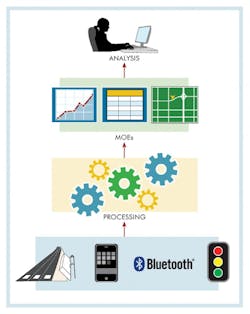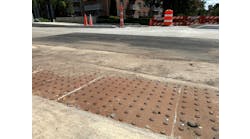Adaptive signal-control technology (ASCT) describes any system that collects traffic detector data, evaluates traffic-signal performance and then updates signal timing in response to that evaluation.
As part of the Every Day Counts initiative, the Federal Highway Administration (FHWA) actively promoted the implementation of ASCT to improve traffic-signal-system operations. As the cost of communications and detection systems has been reduced substantially over the last 10 years, ASCT systems have become more cost-effective. However, the basic issue of performance comparisons remains.
FHWA developed a model system-engineering process to facilitate the implementation of ASCT with the intent to address the risks that, when unchecked, have resulted in the failure or discontinued use of many ASCT deployments in the U.S. The model system-engineering documents guide the production of a concept of operations, system requirements, a verification plan and a validation plan.
The two V’s
Verification is a process that confirms that the system implemented meets stated requirements. Verification is largely an inspection process by which the agency observes that the procured system includes the features that were requested in the requirements.
Validation is the process by which the features and capabilities of the system are measured against the stated operational needs and objectives of the agency in procuring and deploying the technology.
Validation of an ASCT does not imply that the solution is superior to any other available option, including implementation of alternative fixed-timing plans or any of the other wide-ranging features of actuated coordinated controllers. In many cases, simple adjustments to actuated operation can go a long way toward accommodating variability without the expense and complexity of adding ASCT. (Many of these valuable features can be found in FHWA-HOP-11-027.)
Generic validation tools and free open-source software were developed to bring agencies closer to unbiased validation of performance. This system fuses data from four different field sources and computes generic measures of effectiveness (MOEs). These MOEs can then be used to validate the various operational objectives of an agency in deploying the ASCT.
Operational objectives support high-level agency goals, such as minimizing congestion, accommodating long-term variability in travel demand and responding to incidents and special events. Goals like “accommodate long-term variability” are difficult to test numerically, so we identified a number of objectives that have quantitative MOEs that can be calculated from one of the four primary data sources.
Changing conditions
ASCTs are best suited to improving operations when the traffic demands are variable. Something in the traffic system changes or is changing, either quickly in minutes or slowly in days, months or years, and the existing signal timings are not appropriate for the new situation. This results in unnecessary degradation of the traffic performance. Collecting performance measurements that validate that your system reacts to changing situations is the key to effective deployment of ASCT.
FHWA developed a model system-engineering process to facilitate the implementation of ASCT with the intent to address the risks that, when unchecked, have resulted in the failure or discontinued use of many ASCT deployments in the U.S.
Over the years there have been many attempts at measuring performance associated with different ASCTs. Most of the challenge in past studies lies in the available budget for data collection. Collecting route travel-time data is the most common evaluation approach for traffic studies, but it also is one of the most time- and cost-prohibitive.
A relatively low number of runs can be used to compare travel-time averages, but are not effective in assessing improvements to travel-time reliability that may result from application of ASCT. Further, when budgets are limited, travel-time runs are most commonly collected only during peak periods. Limiting travel-time runs to only the peaks may not reflect the capability of the ASCT to improve conditions during the shoulder and off-peak times, where ASCT may actually have more impact when demands are more variable and less predictable.
Almost all studies approach the data-collection efforts in a before-and-after format, and the data collected is quite limited in duration. In particular, studies neglect the collection of measures that reflect the ASCT capabilities to modify its operation to efficiently accommodate variations.
It also is not uncommon to collect the before and after conditions with several months of time in between the two studies. Over this time, travel demand can—and typically does—change due to a variety of reasons, such as site development and seasonal changes. Performance is much better assessed using on/off techniques where the on and off days are randomized over a reasonably substantial length of time. While an on/off approach may be more scientifically defensible, such a study is typically more difficult to support politically by the agency owners. Laypersons and nontechnical stakeholders frequently view the intentional disabling of a beneficial technology as imprudent.
Benefit compared to what?
Even considering these issues, the largest contributor to the uncertainty about the benefits of ASCT is due to the quality of timings that the new system has been compared with. Some reports of hugely successful deployments (90% reductions in stops, etc.) have compared the ASCT with poorly configured or significantly outdated timings. ASCTs that perform poorly are often compared with recently optimized timings or timings that are already largely suitable for typical conditions.
Traffic-engineering principles are based on soundly developed theory, so there is no reason to assume that an ASCT can outperform traditional signal timing under stable flow conditions. Both situations are accurate assessments of ASCT value but tend to inappropriately distort comparisons between systems when agency owners use such data to decide which system to procure and implement.
Further, extrapolations of performance improvements of a given after performance to a benefit-cost ratio and aggregate impacts to emissions and fuel savings are particularly approximate in nature. These extrapolations typically assume that the percentage savings would accrue at the same rate for the system life cycle, which is probably not accurate, since many agencies re-time signals on some reasonable schedule (three to five years) or in response to repeated trouble calls. While most laypersons believe that agencies do nothing about traffic, even the most resource-challenged agency responds to citizen complaints.
There are four types of data necessary for computing the validation MOEs:
• High-resolution phase-timing and detector-actuation data collected by the ASCT, signal system or controller;
• High-resolution GPS probe-vehicle-trajectory data;
• Travel-time and origin-destination data collected by vehicle reidentification equipment; and
• Volume data collected by system-detection zones or vehicle-counting equipment.
Several controller vendors now provide high-resolution logs on the controller and allow an external process to retrieve the information as a binary file via FTP. This method is highly efficient in retrieval of detailed data without constant connectivity to the field device. A typical comparative analysis between adaptive timings and coordination timings can easily show that the ASCT is more focused on the access-equity objective than a smooth-flow objective (vehicles traveling on the main arterial route are considered more important than side-street users).
A comparison of adaptive (top) and coordination (bottom) timings in allocation of green time over a day. In this example, the ASCT allocates a little more “slack” green time for each traffic phase, while the coordination system spends more time on coordinated phases (orange and red lines) and less time on left turns (blue and green lines).
Summary
Management of expectations is an important component of deploying and implementing any new technology. ASCT is particularly challenging in this regard, since it carries a certain expectation from the decision makers and the general public that traffic congestion will be magically wiped away. When the investment cannot be shown to improve operations by X% over the previous type of traffic control, in many cases a poor light is cast on the technology investment.
The history of past validation and evaluation approaches also muddies the waters, because often they either (a) intentionally make the before case as poor as possible or (b) intentionally make the before case as good as possible or even (c) update the signal timings to be as good as possible and then apply ASCT on top of the improved timings.
In this project we took some steps toward providing MOEs that could independently assess the performance of a traffic-control strategy, without having to compare the strategy against something else. In addition, the performance metrics apply to both traditional and ASCT operations. Much more work is needed to develop higher-level performance metrics that combine measurements at multiple intersections and along routes to validate that a particular strategy is meeting the agency’s objectives for deployment in a system-wide manner. Such measures need to stand on their own, similar to the grade scores assigned by the Highway Capacity Manual. We hope others will take these ideas and continue to develop new metrics and extend this work in new and innovative ways.
For more information on this topic, visit http://ops.fhwa.dot.gov/arterial_mgmt/tst_ops.htm. TM&E



